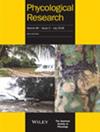巴西沿海不同植物区系的假musciformhypnea生态型(Cystocloniaceae, rhodophyia)的耐热性
IF 1
4区 生物学
Q2 MARINE & FRESHWATER BIOLOGY
引用次数: 1
摘要
研究温度对生理过程的影响是建立大型藻类生物地理分布模型的必要条件。在巴西沿海(约3.000 km) 3个区系省(热带、过渡型和暖温带)收集到假musciformis四孢子植物,代表3种生态型。分别在20°C、24°C、28°C和32°C条件下培养21 d,分析生长率、光合作用和色素含量等生理参数。假mususciformis标本耐受20°C至32°C的温度变化。然而,所有生态型在32°C时的生理性能均显著下降。我们假设来自热带省的假musciformis生态型已经生活在其热生理极限,仅在冬季(6月至9月)达到最大生长,而温暖温带生态型在夏季(12月至3月)达到最大生长。这种广泛的热最佳可能是这个物种沿着巴西海岸广泛分布的原因,使它能够占据不同的热环境。本文章由计算机程序翻译,如有差异,请以英文原文为准。
Thermal tolerance of Hypnea pseudomusciformis ecotypes (Cystocloniaceae, Rhodophyta) related to different floristic provinces along the Brazilian coast
Studies on the effects of temperature on physiological processes are essential to model macroalgae biogeographic distribution. Tetrasporophytes of Hypnea pseudomusciformis were collected from three floristic provinces (tropical, transition and warm temperate) along the Brazilian coast (~3.000 km), representing three ecotypes. Specimens were cultured under 20°C, 24°C, 28°C and 32°C for 21 days, then physiological parameters (growth rates, photosynthesis and pigments content) were analyzed. H. pseudomusciformis specimens tolerated a temperature variation from 20°C to 32°C. However, all ecotypes displayed a significant decrease in physiological performance at 32°C in all parameters analyzed. We hypothesized that the H. pseudomusciformis ecotype from the tropical province is already living at its thermal physiological limit, reaching its maximum growth only in the winter months (June to September), whereas a warm temperate ecotype reaches maximum growth in the summer months (December to March). This wide thermal optimum may be the reason for the widespread distribution of this species along the Brazilian coast, allowing it to occupy different thermal environments.
求助全文
通过发布文献求助,成功后即可免费获取论文全文。
去求助
来源期刊

Phycological Research
生物-海洋与淡水生物学
CiteScore
3.60
自引率
13.30%
发文量
33
审稿时长
>12 weeks
期刊介绍:
Phycological Research is published by the Japanese Society of Phycology and complements the Japanese Journal of Phycology. The Journal publishes international, basic or applied, peer-reviewed research dealing with all aspects of phycology including ecology, taxonomy and phylogeny, evolution, genetics, molecular biology, biochemistry, cell biology, morphology, physiology, new techniques to facilitate the international exchange of results. All articles are peer-reviewed by at least two researchers expert in the filed of the submitted paper. Phycological Research has been credited by the International Association for Plant Taxonomy for the purpose of registration of new non-vascular plant names (including fossils).
 求助内容:
求助内容: 应助结果提醒方式:
应助结果提醒方式:


